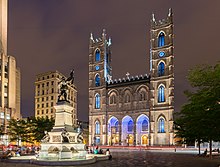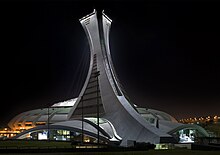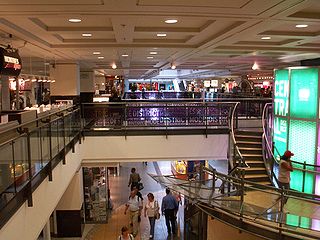
RÉSO, commonly referred to as the Underground City, is the name applied to a series of interconnected office towers, hotels, shopping centres, residential and commercial complexes, convention halls, universities and performing arts venues that form the heart of Montreal's central business district, colloquially referred to as Downtown Montreal. The name refers to the underground connections between the buildings that compose the network, in addition to the network's complete integration with the city's entirely underground rapid transit system, the Montreal Metro. Moreover, the first iteration of the Underground City was developed out of the open pit at the southern entrance to the Mount Royal Tunnel, where Place Ville Marie and Central Station stand today.

1000 de la Gauchetière is a skyscraper in Montreal, Quebec, Canada. It is named for its address at 1000 De la Gauchetière Street West in the downtown core. It is Montreal's tallest building as per the height definition of the National Building Code of Canada that is used by the city of Montreal, which excludes spires. For international comparison, spires are included as per the Council on Tall Buildings and Urban Habitat's most widely used height definition for building height and the building is thus the second tallest building as per this definition. It rises to the maximum elevation approved by the city at 232.5m above mean sea level with a total height from the average ground level around first floor to roof of 205m (673ft) and 51 floors. A popular feature of the building is its atrium, which holds a large ice skating rink. The building was not subject to the 1992 municipal maximum height of 200m because it was finished in 1992.
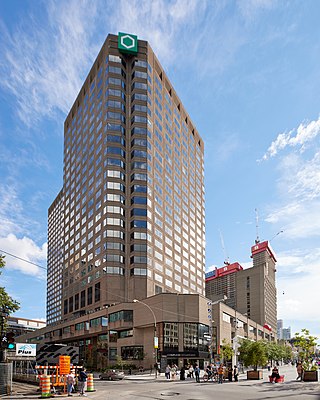
Complexe Desjardins is a mixed-use office, hotel, and shopping mall complex located in Montreal, Quebec, Canada, in the Quartier des spectacles area of Saint Catherine Street. The project was designed to develop the eastern end of downtown Montreal, it is located in the quadrilateral formed by Saint Catherine, Saint-Urbain, Jeanne Mance and René Lévesque Boulevard.

Old Montreal is a historic neighbourhood within the municipality of Montreal in the province of Quebec, Canada. Home to the Old Port of Montreal, the neighbourhood is bordered on the west by McGill Street, on the north by Ruelle des Fortifications, on the east by rue Saint-André, and on the south by the Saint Lawrence River. Following recent amendments, the neighbourhood has expanded to include the Rue des Soeurs Grises in the west, Saint Antoine Street in the north, and Saint Hubert Street in the east.
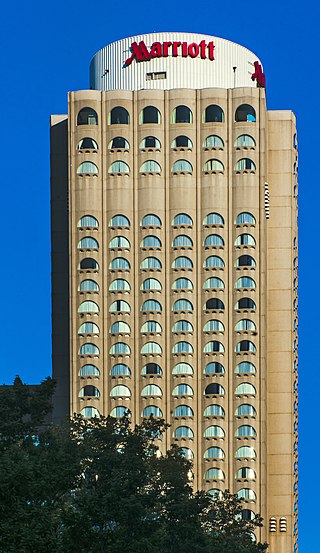
The Montreal Marriott Château Champlain is a skyscraper hotel located in Montreal, Quebec, Canada, overlooking Place du Canada, at 1050 De la Gauchetière Street West.
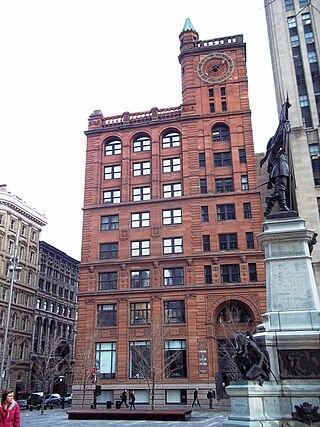
Montreal's New York Life Insurance Building is an office building at Place d'Armes in what is now known as Old Montreal, erected in 1887–1889. At the time of its completion, it was the tallest commercial building in Montreal with the first eight floors were designed for retail office space, that quickly filled with the city's best lawyers and financiers. When the clock tower was completed, the owner filled the ninth and tenth floors with the largest legal library in the entire country as a gift to tenants. The building is next to another historic office tower, Aldred Building.

The Palais de justice is a courthouse in Montreal, Quebec, Canada. It is located at 1 Notre-Dame Street East in the Old Montreal neighbourhood of the Ville-Marie borough. It was completed in 1971.

Downtown Montreal is the central business district of Montreal, Quebec, Canada.

Place d'Armes is a square of the Old Montreal quarter of Montreal, in Quebec, Canada anchored by a monument in memory of Paul de Chomedey, founder of Montreal. Buildings that surround it include Notre-Dame Basilica, Saint-Sulpice Seminary, New York Life Building, Aldred Building, Bank of Montreal head office and 500 Place D'Armes.

The architecture of Quebec, was characterized in the beginning by the settlers of the rural areas along the St. Lawrence who largely came from Normandy. The houses they built echoed their roots. The surroundings forced enough differences that a unique style developed, and the house of the New France farmer remains a symbol of French-Canadian nationalism. These were rectangular structures of one storey, but with an extremely tall and steep roof, sometimes almost twice as tall as the house below. This roof design perhaps developed to prevent the accumulation of snow. The houses were usually built of wood, though the surviving ones are almost all built of stone. Landmarks in the rural areas were the churches and the mansion of the seigneurs. The seigneurs built much larger homes for themselves, but rarely were the manors ornate. Each parish had its church, often smelter copies of major churches in Quebec City or Montreal. A unique style of French-Canadian homo church thus developed.
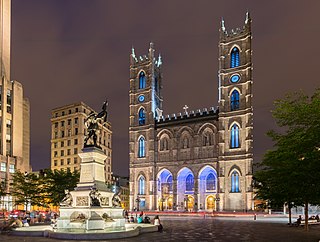
Notre-Dame Basilica is a minor basilica of the Catholic Church in the historic Old Montreal district of Montreal in Quebec, Canada. It is located at 110 Notre-Dame Street West, at the corner of Saint Sulpice Street. It is situated next to the Saint-Sulpice Seminary and faces the Place d'Armes square.

500 Place d'Armes is an International style building on the historic Place d'Armes square in Old Montreal quarter of Montreal, Quebec, Canada.

The Aldred Building is an Art deco building on the historic Place d'Armes square in the Old Montreal quarter of Montreal, Quebec, Canada.

Dorchester Square, originally Dominion Square, is a large urban square in downtown Montreal. Together with Place du Canada, the area is just over 21,000 m2 (230,000 sq ft) or 2.1 ha of manicured and protected urban parkland bordered by René Lévesque Boulevard to the south, Peel Street to the west, Metcalfe Street to the east and Dorchester Square Street to the north. The square is open to the public 24 hours a day and forms a focal point for pedestrian traffic in the city. Until the creation of Place du Canada in 1967, the name "Dominion Square" had been applied to the entire area.

Complexe Maisonneuve is an office building complex in Montreal, Quebec, Canada. Complexe Maisonneuve is located on De la Gauchetière Street West between University Street and Beaver Hall Hill. It is situated facing Victoria Square in the Quartier international district of Downtown Montreal, and is linked to Montreal's Underground City and Square-Victoria-OACI Station on the Montreal Metro. The complex consists of two buildings, the 600 de La Gauchetière and the 700 de La Gauchetière which were built at the same time in 1983 but are owned by different real estate companies.

Saint Joseph's Oratory of Mount Royal is a Roman Catholic minor basilica and national shrine located at 3800 Queen Mary Road in the Côte-des-Neiges neighborhood on Mount Royal's Westmount Summit in Montreal, Quebec. It is a National Historic Site of Canada and is Canada's largest church, with one of the largest church domes in the world. Founded in 1904 by Saint André Bessette in honour of his patron saint, Saint Joseph, the Oratory is the product of numerous architects and thousands of workers in a process spanning six decades. With its monumental scale, Renaissance Revival facade and contrasting Art Deco interior, the Oratory is recognizable not just in Montreal but around the world, attracting more than 2 million visitors and pilgrims to its steps each year.
Dimitri Dimakopoulos was a Greek-Canadian architect. He was best known for having been involved in the design of several notable buildings in Downtown Montreal.

